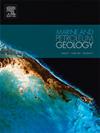Laminae in multiple lithofacies and impact on pore structures in lacustrine shale: The cretaceous qingshankou formation, Songliao Basin
IF 3.7
2区 地球科学
Q1 GEOSCIENCES, MULTIDISCIPLINARY
引用次数: 0
Abstract
Unconventional lacustrine shale oil reservoirs are characterized by strong heterogeneity of pore structures and intensive lithofacies variations in the vertical direction. This study systematically investigated the pore systems and factors influencing pore structures for the first member of the Cretaceous Qingshankou Formation (Qing 1 member) in southern Songliao Basin, employing geochemical, mineralogical, petrological, and petrophysical methods. Nine lithofacies types were identified based on total organic carbon (TOC) content-laminae structure-mineral composition. Organic-medium mixed lithofacies with silt-laminated structures were the most favorable in the Qing 1 shale, exhibiting dominant pore volume, exceptional connectivity, and significant movable oil content. Shale reservoirs were primarily controlled by interparticle pores and microfractures, with mesopores as the dominant reservoir space. Thick argillaceous laminae followed a "primary source and reservoir rock" model at the microscale, whereas "oil generation-migration-accumulation" in silt-laminated shale played a key role in pore system development. In the Qing 1 shale at the medium maturity stage, TOC content negatively impacted storage space due to asphalt blocking pores. Due to the in situ deposition of authigenic minerals and dissolved components, felsic minerals also negatively effected pore volume. Moreover, shales developed a significant number of pores associated with clay minerals to enhance reservoir space. Furthermore, an optimal balance of felsic minerals in the argillaceous laminae alleviated compaction. These findings enhance our understanding of pore formation mechanisms for lacustrine shale reservoir, which is crucial for accurately assessing shale oil resources.
求助全文
约1分钟内获得全文
求助全文
来源期刊

Marine and Petroleum Geology
地学-地球科学综合
CiteScore
8.80
自引率
14.30%
发文量
475
审稿时长
63 days
期刊介绍:
Marine and Petroleum Geology is the pre-eminent international forum for the exchange of multidisciplinary concepts, interpretations and techniques for all concerned with marine and petroleum geology in industry, government and academia. Rapid bimonthly publication allows early communications of papers or short communications to the geoscience community.
Marine and Petroleum Geology is essential reading for geologists, geophysicists and explorationists in industry, government and academia working in the following areas: marine geology; basin analysis and evaluation; organic geochemistry; reserve/resource estimation; seismic stratigraphy; thermal models of basic evolution; sedimentary geology; continental margins; geophysical interpretation; structural geology/tectonics; formation evaluation techniques; well logging.
 求助内容:
求助内容: 应助结果提醒方式:
应助结果提醒方式:


